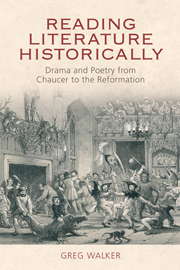Book contents
- Frontmatter
- Contents
- Acknowledgements
- Dedication
- Introduction: Literature and History: The Risks of Conversation
- Part I Drama
- 1 Early Tudor Drama and the Arts of Resistance
- 2 ‘To Speak before the King, it is no Child's Play’: Godly Queen Hester in 1529
- 3 Flytyng in the Face of Convention: Protest and Innovation in Lindsay's Satyre of the Thrie Estaitis
- Part II Poetry, 1380–1532
- Index
3 - Flytyng in the Face of Convention: Protest and Innovation in Lindsay's Satyre of the Thrie Estaitis
from Part I - Drama
Published online by Cambridge University Press: 05 October 2013
- Frontmatter
- Contents
- Acknowledgements
- Dedication
- Introduction: Literature and History: The Risks of Conversation
- Part I Drama
- 1 Early Tudor Drama and the Arts of Resistance
- 2 ‘To Speak before the King, it is no Child's Play’: Godly Queen Hester in 1529
- 3 Flytyng in the Face of Convention: Protest and Innovation in Lindsay's Satyre of the Thrie Estaitis
- Part II Poetry, 1380–1532
- Index
Summary
On 6 January 1540, the Scottish court watched an embryonic version of Sir David Lindsay's great drama, Ane Satyre of the Thrie Estaitis. What they saw seems, from the only surviving account, to have been an innovative reworking of the conventions of the moral interlude for political ends. In the great hall of Linlithgow Palace, in the presence of James V, and in a court culture predicated upon the authorising presence of an adult male sovereign, Lindsay presented the king with a dramatic speculum principis in which he might see conventional good counsel impersonated for his benefit. Rather than follow morality convention, however, and represent the temptation, fall and restoration of a protagonist whose fortunes might serve as an example to his royal spectator, Lindsay seems to have built his play around a series of entrances into the hall. Adapting his drama to its location in the royal household, he brought in a series of visitors and suitors to the king, echoing both the protocols of the royal audience chamber and the parliament hall, and perhaps also the more spectacular entries characteristic of courtly masks.
Having given room to the boastful antics of a trio of sycophantic courtiers (Placebo, Pickthank and Flattery), and the arrival of the three Estates of Parliament, the main business of the play involved the entry of the Poor Man, who presented a lengthy petition for redress of his destitute condition.
- Type
- Chapter
- Information
- Reading Literature HistoricallyDrama and Poetry from Chaucer to the Reformation, pp. 63 - 90Publisher: Edinburgh University PressPrint publication year: 2013



